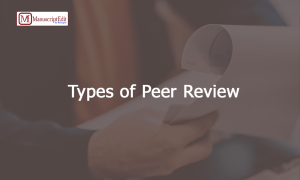|
Getting your Trinity Audio player ready...
|
Following the submission of the manuscript, a preliminary review round is conducted by the editor to determine whether the manuscript is consistent with the journal’s aim and scope. To analyze the research’s quality, it is moved to the desk of peer reviewers before getting published. This collective process is termed as “Peer review.” It is an essential component of scholarly publication because it is responsible for screening authentic research content and providing readers with reliable data. In academic publishing, peer review processes are classified into seven types.
The main distinction is how well the editors, reviewers, and authors are aware of the identities of each other.
1) Single-Blind Review
A single-blind review is also known as a single anonymized review. It is the most common one among all the types.
Here, the reviewers are aware of the author’s identity, but it does not disclose the reviewer’s details to the author.
This allows reviewers to provide feedback without the fear of interference from the author.
2) Double-Blind Review
Both the author and the reviewers are unaware of each other in a double-blind (or double-anonymized) review. This process conceals the identities from each other.
It is believed that double-blind review helps in the publication of manuscripts on the basis of merit instead of the reputation of the author.
3) Open Peer Review
It discloses the identities of both reviewer and the author. It usually means that the reviewers are aware of your identity as an author and that your identity will be revealed to you at some point during the review or publication process. One of the major disadvantages of this process is that the identification may influence the review process.
4) Post-Publication Review
In this process, review occurs after publication. Some journals provide this exclusive platform of post-publication peer review.
5) Transparent Review
The author’s identity is disclosed in a transparent peer review, but the reviewers can choose if they want to share their identities or not. Their identities cannot reveal until the report is signed by them.
6) Collaborative Review
This process provides an opportunity for discussion between the reviewers and authors among themselves during the process directly to improve the manuscript. It provides a rich forum for discussion and allows all groups to resolve any conflicts or dichotomies in real time. As a result, this can reduce multiple editing rounds. However, the identities of the reviewers are not made public prior to publication, although they can become public at the time of publication.
But this process consumes time and resources. To implement this set system, frequently a technological platform must be in place, where staffs are needed to monitor and repair any sorts of bugs and glitches.
7) Cascading Peer Review
If the editor rejects a manuscript for incompatible niche or low priority, he/she refers the author to an alternate journal for submission along with the reviewer’s report.
It helps the author to publish his/her manuscript, although it takes more time than the traditional methods.
Conclusion:
It is up to the journal to determine the type of peer review process for each paper. However, not all publications follow the peer review process.
But, publishing peer-review materials alongside articles increase the transparency of the peer-review process and provide readers with credible sources of information.
Ms. Smruti Trupta D




